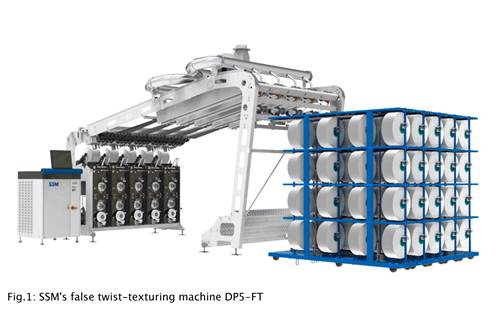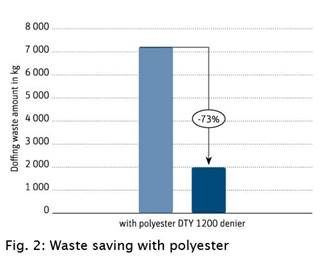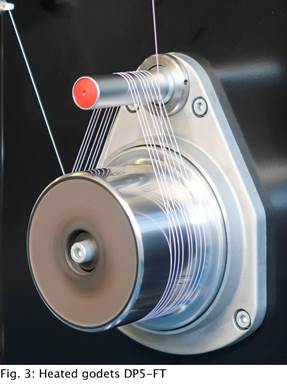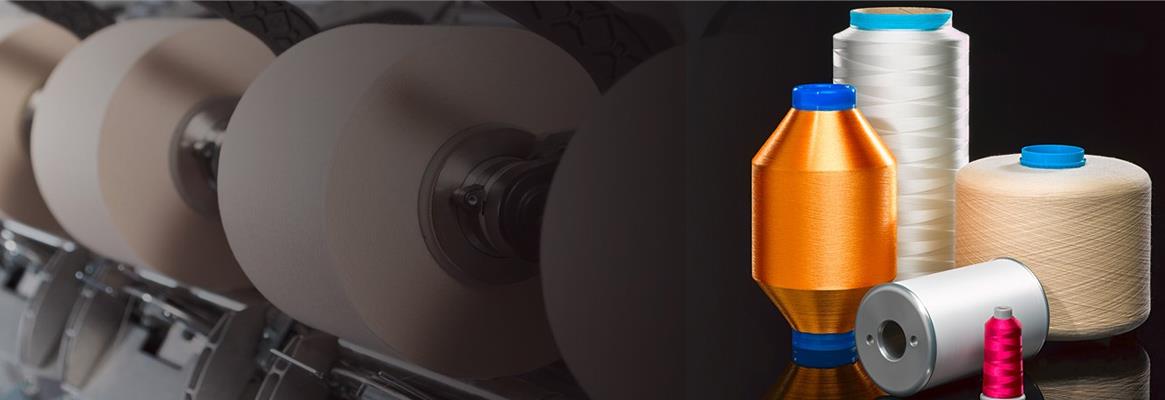The SSM single-position machine concept for various applications False-twist texturing is a cost-competitive sector of the textile industry. A winning strategy in this area is to produce specialty yarns with added value. With the launch of the new false-twist texturing machine DP5-FT, SSM is offering the right tool for this specialties market.
Polyester DTY (Drawn Textured Yarn) was first produced in the 1960s and has since become a commodity yarn. However, over time, polyester yarns have evolved to be used in a variety of specialty yarns, ranging from coarse denier per filament (dpf) to micro-filament and even super-micro-filament yarns. These yarns can be used to produce fabrics with a very soft touch and a light weight.
Filaments with different cross-sectional shapes improve perspiration evaporation or provide the fabric with a distinctive luster. Another specialty is achieved by encapsulating functional chemicals directly into the polymer to create fabrics with additional characteristics such as anti-bacterial properties to eliminate odors or using infrared body emissions to increase body temperature. Furthermore, an increase in dope dyed POY (Partially Oriented Yarn) brings advantages for color fastness and in terms of environmental friendliness, as no subsequent dyeing is required.
All these specialties are the new standard in DTY and bring new challenges for texturizers, e.g., the need for more flexibility in production, as more specialties mean more but smaller lots to be produced. Thanks to the DP5-T, SSM is already in a strong leading position in the air-texturing market; now it is solidifying this position by launching the most flexible false-twist texturing machine, the DP5-FT (Fig. 1).

A single-position machine concept for full flexibility
An entire DP5-FT machine with 40 positions can be set up with up to 40 different recipes. Every position is almost a standalone false twist (FT) machine with its own heater, control board and is furthermore equipped with individually driven, programmable motors.
Several draw ratios and temperatures can be adjusted between different positions to achieve the best possible result for every color shade of a dope dyed POY – an advantage that sets the machine apart from others in the market.
There is no need to invest in an equivalent laboratory machine. Customers can simply dedicate one or multiple positions of the DP5-FT to trials and sampling. The position(s) can be reassigned back to normal production later to maximize efficiency and reduce sampling costs.
The individual position concept also brings advantages in terms of power consumption and production efficiency. Unlike shaft machines, the power consumption of a position is reduced when it is not in use, as all affected motors are stopped. Moreover, a power-saving function can be activated after a certain amount of idle time has elapsed to reduce the temperature of the heater and godet – maximizing the potential savings. On a running shaft machine, it is also common to find positions without yarn, because a wrap after a yarn break cannot safely be removed while running, or because a faulty position is awaiting the next machine stop. There are no such limitations with an individual position machine concept because each position can be stopped individually and serviced immediately, resulting in higher machine efficiency.
Further savings can be made by lowering the heat-setting godet’s temperature without altering the machine efficiency, as the SSM induction-heated godets recover their set temperature in a very short time.
Last but not least, the DP5-FT is the first choice for manufacturers whose top priority is personal safety, as the individual position concept allows the use of much smaller motors, limiting the risk of severe injuries to operators.
Impressive reduction of waste during doffing
Developing specific software features enables the yarn delivery speed to be reduced during doffing, which in turn significantly reduces yarn waste – a unique benefit compared to shaft machines that use the same motor for all positions and varying doffing times.

The higher the yarn count, the higher the savings. Reducing the doffing waste by up to 73% for a 1 200 den (4 times 300 den) yarn (Fig. 2), corresponds to an impressive reduction of waste of more than 5 tons per year. With a price of 1.3 USD/kg for polyester POY, this feature allows savings of up to 6 500 USD per year on raw materials for a machine with 40 positions.
Flexibility to increase production capacity
The high flexibility of the DP5-FT is reflected in the minimum available number of five positions only, making it the perfect solution for customers entering the DTY business. It enables full flexibility in terms of lot sizes, types and counts of DTY yarns as well as better control of the supply chain. If a customer later wants to increase the DTY production capacity, the machine can be extended to include up to 40 positions without changing the head stock and using the same machine terminal.
A substantial cost reduction
The optional elastane feeder is another asset of the DP5-FT. It allows a single-step production of air covered yarns, which consist of DTY and elastane that are combined using an airjet. SSM comparative tests proved that a higher quality of air covering is achieved if both the texturing and air-covering processes are combined in one single step. Freshly produced DTY features higher elasticity and thus allows optimum relaxation in the air-jet for superior covering quality – compared to a conventional two-step process where DTY is air covered on a dedicated machine. Reducing the air-jet pressure from four to three bar does not just lead to superior yarn quality – it also reduces costs. In numbers, it means a substantial cost reduction of more than 4 000 USD annually for a 40-position machine operating for 8 000 hours.
The DP5-FT is supplied in a double density version with two spindles per position as standard to produce 2-ply yarns at the highest level of efficiency. Optionally, up to four spindles per position can be installed to produce 4-ply yarns without losing productivity, as all take-up is used in this configuration. Carpet yarn producers highly appreciate this setup, as it enables them to produce 1 200 denier (4 times 300 den) balanced yarns (2 S twists 2 Z twists) in one single step and thus maximizes their productivity.
The DP5-FT can also be equipped with a second drawing roller for producing plied yarns using various materials. For example, polyester/polyamide can be used simultaneously on the same position, as both materials can be drawn independently at different levels. This option means trendy DTY yarns can be produced, e.g. two-tone yarns made of the same material but drawn at different levels, resulting in differing dye absorption to get special color effects. These types of yarn are in high demand from the fashion industry.

Full control and inspection without stopping the machine A unique feature of SSM texturing machines is the heated godet (Fig. 3) to heat-set the DTY yarn and achieve the required elasticity. This is state-of-the-art in the production of polyester DTY yarns. Due to their length, tube heaters on competitors’ machines are installed at the rear of the machine or underneath the catwalk. Therefore, operators can’t inspect them during production or remove the internal tube periodically for cleaning. On SSM texturing machines, the heat-setting godet is located at the front of the machine, enabling full control and inspection of the entire yarn path at any time without stopping the machine. Instead of using a tube heater with a predefined length, using a godet also allows operators to influence the duration of the heat setting process by increasing or decreasing the number of wraps around the godets.
With this modern machine concept, SSM offers texturizers a proper tool to stay at the forefront of the competitive DTY specialty market.










Comments